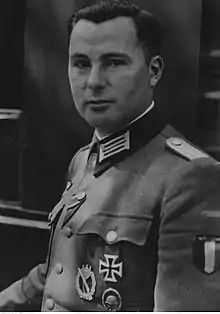Rexist Party
The Rexist Party (French: Parti Rexiste), or simply Rex, was a far-right Catholic, nationalist, authoritarian and corporatist[9] political party active in Belgium from 1935 until 1945. The party was founded by a journalist, Léon Degrelle,[10] and, unlike other fascist parties in the Belgium of the time, advocated Belgian unitarism and royalism. Initially, the party ran in both Flanders and Wallonia, but it never achieved much success outside Wallonia and Brussels. Its name was derived from the Roman Catholic journal and publishing company Christus Rex (Latin for Christ the King).
Rexist Party Parti Rexiste | |
|---|---|
 | |
| Founder | Léon Degrelle |
| Founded | 2 November 1935 |
| Dissolved | 30 March 1945 |
| Split from | Catholic Party |
| Headquarters | Brussels, Belgium |
| Newspaper | Le Pays Réel |
| Paramilitary wing | Formations de Combat[1][2] |
| Ideology | Belgian nationalism Political Catholicism[3] Authoritarian conservatism Corporate statism[4] Fascism (from 1937)[5][6] Nazism (from 1940)[7] |
| Political position | Far-right |
| Religion | Roman Catholicism |
| Political alliance | VNV (1936–1937)[8] |
| Colours | Red Black |
| Anthem | Vers l'Avenir transl. "Towards the future" |
| Party flag | |
 | |
The highest electoral achievement of the Rexist Party was its gaining of 21 out of 202 deputies (with 11.4% of the vote) and twelve senators in the 1936 election.[11] Never a mass movement, it was on the decline by 1938. During the German occupation of Belgium in World War II, Rex was the most significant collaborationist group in French-speaking Belgium, paralleled by the Vlaamsch Nationaal Verbond (VNV) in Flanders. By the war's end, Rex was widely discredited and banned following the liberation.
Initially modelled on Italian Fascism and Spanish Falangism, it later drew closer to German Nazism. The Party espoused a "right-wing revolution" and the dominance of the Catholic Church in Belgium,[12] but its ideology came to be vigorously opposed by the leader of the Belgian Church Cardinal van Roey, who called Rexism a "danger to the church and the country".[11]
Ideology
The ideology of Rex, which was loosely based on the writings of Jean Denis, called for the "moral renewal" of Belgian society through the dominance of the Catholic Church by forming a corporatist society and abolishing liberal democracy.[13] Denis became an enthusiastic member of Rex, and later wrote for the party newspaper Le Pays Réel. The original programme of Rexism borrowed strongly from Charles Maurras' integralism. It rejected liberalism, which it deemed decadent, and was strongly opposed to both Marxism and capitalism, instead striving for a corporatist economic model, idealising rural life and traditional family values.[6]
In its early period — until around 1937 — Rexism cannot accurately be categorised as a fascist movement. Instead, it was a populist,[6] authoritarian and conservative Catholic nationalist movement[14] that initially tried to win power by democratic means, and did not want totally to abolish democratic institutions. The party increasingly made use of fascist-style rhetoric, but only after Degrelle's defeat in a by-election in April 1937 did it openly embrace anti-Semitism and anti-parliamentarian, following the model of German Nazism. Historian and expert on fascism Roger Griffin only considers the Rexist Party during the German occupation of Belgium as "fully fascist"; until then, he considers it "proto-fascist".[15]
The Rexist movement attracted support almost exclusively from Wallonia. On 6 October 1936, party leader Léon Degrelle made a secret agreement with Rex's Flemish counterpart, the Vlaams Nationaal Verbond (VNV; "Flemish National Union") led by Staf De Clercq.[16] Both movements strove for a corporatist system. Still, unlike the Rexists, the VNV sought to separate Flanders from Belgium and to unite it with the Netherlands. The Flemish side cancelled the agreement after just one year.[17] It also faced competition from the ideologically similar (but explicitly anti-German) Légion Nationale ("National Legion") of Paul Hoornaert.
Pre-war politics
The Rexist Party was founded in 1935 after its leader Léon Degrelle had left the mainstream Catholic Party, which he deemed too moderate. It targeted disappointed constituencies such as traditionalist Catholics, veterans, small traders and jobless people. In the Depression era, it initially won considerable popularity — mostly due to its leader's charisma and energy. Its most tremendous success was winning 11.5 per cent of the total vote in the 1936 election.[18] On that occasion the Rexist Party took 21 of the 202 seats in the Chamber of Deputies and 8 out of 101 in the Senate, making it the fourth-strongest force in Parliament, behind the significant established parties (Labour, Catholic, Liberal).
However, the support for the party (even at its height) was extremely localized: Rexists succeeded in garnering over 30 per cent of the vote in the French-speaking province of Luxembourg, compared with just 9 per cent in equally French-speaking Hainaut.[13] Degrelle admired Adolf Hitler's rise to power and progressively imitated the tone and style of fascist campaigning, while the movement's ties to the Roman Catholic Church were increasingly repudiated by the Belgian clergy.
Degrelle ran in the April 1937 Brussels by-election against Prime Minister Paul van Zeeland of the Catholic Party, who was supported — in the hope of thwarting a Rexist victory — by all other parties, including even the Communists.[19] The Archbishop of Mechelen and primate of the Catholic Church of Belgium, Jozef-Ernest Cardinal van Roey, intervened, rebuking Rexist voters, insisting that even abstention from voting would be sinful, and calling Rexism "a danger to the country and to the Church". Degrelle was decisively defeated: he obtained only 20 per cent of the vote, the rest going to Van Zeeland.[20]
Afterwards, Rexism allied itself with the interests of Nazi Germany even more strongly and incorporated Nazi-style antisemitism into its platform. At the same time, its popularity declined sharply.[21] In the 1939 national election, Rex's share of votes fell to 4.4 per cent, and the party lost 17 of its 21 seats, largely to the mainstream Catholic and Liberal parties.[21]
Second World War
| Part of a series on |
| Fascism |
|---|
 |
With the German invasion of Belgium in 1940, Rexism welcomed German occupation, even though it had initially supported the pre-war Belgian policy of neutrality.[22] While some former Rexists went into the underground resistance or (like José Streel) withdrew from politics after they had come to see the Nazis' anticlerical and extreme anti-Semitic policies enforced in occupied Belgium, most Rexists, however, proudly supported the occupiers and assisted German forces with the repression of the territory wherever they could.[22] Nevertheless, the popularity of Rex continued to drop. In 1941, at a reunion in Liège, Degrelle was booed by about a hundred demonstrators.[22]
In August 1944, a Rexist militia was responsible for the Courcelles Massacre.
Collaboration
Closely affiliated with Rex was the Walloon Legion, a unit within the German Army (Wehrmacht) and later the Waffen-SS raised from French-speaking volunteers in Belgium with Rexist support after German invasion of the Soviet Union. After an initial failure to attract recruits, Degrelle volunteered for the unit as a publicity stunt and spent much of the rest of the war outside Belgium on the Eastern Front. He increasingly saw the Walloon Legion as a better vehicle for seeking German support than the Rexist Party, and recruitment drained the party of its cadres. Whilst Degrelle was absent, nominal leadership of the party passed to Victor Matthys.
Formations de Combat
.svg.png.webp)
The Rexists had their paramilitary wing known as the Formations de Combat (lit. 'Combat Formations'), founded in 1940 and having around 4,000 members.[23][24] Their members wore dark blue uniforms with the red Burgundian cross.[25] Due to the constant depletion of its strength through members volunteering for more active forms of service in the German forces, the Formations had, by the end of 1943, virtually ceased to function.[23]
End of Rexism
The party had been banned from the liberation of Belgium in September 1944. With the fall of Nazi Germany in 1945, many former Rexists were imprisoned or executed for their role during collaboration. Victor Matthys and José Streel were both executed by firing squad, Jean Denis (who had played only a minor role during the war) was imprisoned.
Degrelle took refuge in Francoist Spain. He was convicted of treason in absentia in Belgium and sentenced to death, but repeated requests to extradite him were turned down by the Spanish government. Stripped of his citizenship and excommunicated (later lifted in Germany), Degrelle died in Málaga in 1994.[26]
Leaders
| No. | Leader (birth–death) |
Portrait | Constituency or title | Took office | Left office |
|---|---|---|---|---|---|
| 1 | Léon Degrelle (1906–1994) |
 |
Leader of the Rexist Party | 2 November 1935 | July 1941 |
| 2 | Victor Matthys (1914–1947) |
 |
Leader of the Rexist Party | July 1941 | August 1944 |
| 3 | Louis Collard | Leader of the Rexist Party | August 1944 | 30 March 1945 |
Election results
| Election year | # of overall votes |
% of overall vote |
# of overall seats won |
+/– | Government |
|---|---|---|---|---|---|
| 1936 | 271,481 | 11.49 (#4) | 21 / 202 |
in opposition | |
| 1939 | 83,047 | 4.25 (#6) | 4 / 202 |
in opposition |
See also
References
- Colignon, Alain (2001). "DEGRELLE, Léon" (PDF). Biographie Nationale de Belgique (in French). Vol. VI. Royal Academy of Science, Letters and Fine Arts of Belgium. pp. 111–23. ISSN 0776-3948. Archived (PDF) from the original on 30 August 2021. Retrieved 17 September 2021.
- FORMATIONS DE COMBAT.
- Stanley G. Payne (1984). Spanish Catholicism: An Historical Overview. Univ of Wisconsin Press. p. xiii. ISBN 978-0-299-09804-9.
-
Badie, Bertrand; Berg-Schlosser, Dirk; Morlino, Leonardo, eds. (7 September 2011). International Encyclopedia of Political Science. SAGE Publications (published 2011). ISBN 9781483305394. Retrieved 9 September 2020.
... fascist Italy ... developed a state structure known as the corporate state with the ruling party acting as a mediator between 'corporations' making up the body of the nation. Similar designs were quite popular elsewhere in the 1930s. The most prominent examples were Estado Novo in Portugal (1932–1968) and Brazil (1937–1945), the Austrian Standestaat (1933–1938), and authoritarian experiments in Estonia, Romania, and some other countries of East and East-Central Europe,
- Brustein, William (Feb., 1988). The Political Geography of Belgian Fascism: The Case of Rexism. American Sociological Review. Vol. 53, No. 1. pp. 69-80.
- Griffin, Roger (1991). The Nature of Fascism. Pinter. p. 132.
- Wouters, Nico (2018). "Belgium". In Stahel, David (ed.). Joining Hitler's Crusade: European Nations and the Invasion of the Soviet Union, 1941. Cambridge University Press. pp. 260–287. ISBN 9781316510346.
- Capoccia, Giovanni (2005). Defending Democracy: Reactions to Extremism in Interwar Europe. Johns Hopkins University Press. p. 114.
- Cook, Bernard A. (2005). Belgium: A History (3rd ed.). Peter Lang. p. 118.
- The rexist movement in Belgium, PhD thesis Martin Conway, 1989, University of Oxford
- Richard Bonney Confronting the Nazi War on Christianity: the Kulturkampf Newsletters, 1936–1939; International Academic Publishers; Bern; 2009 ISBN 978-3-03911-904-2; pp. 175–176
- Gerard, Emmanuel; Van Nieuwenhuyse, Karel, eds. (2010). Scripta Politica: Politieke Geschiedenis van België in Documenten (1918–2008) (2e herwerkte dr. ed.). Leuven: Acco. p. 112. ISBN 9789033480393.
- Brustein (1988). "The Case of Rexism".
{{cite journal}}: Cite journal requires|journal=(help) - Étienne, Jean-Michel (1968). Le mouvement Rexiste jusqu'en 1940. Armand Colin.
- Griffin, Roger (1991). The Nature of Fascism. Pinter. pp. 132–133.
- Geheim akkoord tussen Rex en VNV quoted in Gerard, Emmanuel; Van Nieuwenhuyse, Karel, eds. (2010). Scripta Politica: Politieke Geschiedenis van België in Documenten (1918–2008) (2nd revised ed.). Leuven: Acco. pp. 119–20. ISBN 9789033480393.
- Capoccia, Giovanni (2005). Defending Democracy: Reactions to Extremism in Interwar Europe. Johns Hopkins University Press. p. 114.
- De Wever, Bruno (2006). "Belgium". World Fascism: A Historical Encyclopedia. Vol. 1. ABC-CLIO. p. 86.
- Paxton, Robert O. (2004). The Anatomy of Fascism. Alfred A. Knopf. p. 74. ISBN 9781400040940. - Registration required for the page link
- Richard Bonney Confronting the Nazi War on Christianity: the Kulturkampf Newsletters, 1936–1939; International Academic Publishers; Bern; 2009 ISBN 978-3-03911-904-2; pp. 174–175.
- di Muro, Giovanni F. (2005). Léon Degrelle et l'aventure rexiste. Bruxelles: Pire. pp. 151–3. ISBN 2874155195.
- di Muro, Giovanni F. (2005). Léon Degrelle et l'aventure rexiste. Bruxelles: Pire. pp. 160–1. ISBN 2874155195.
- Bruyne, Eddy de (2016). Moi, fuhrer des Wallons! (in French). Editions Luc Pire. ISBN 978-2-507-05430-4.
- "Formations de Combat". www.belgiumwwii.be (in Dutch).
- Littlejohn, David (1981). Foreign legions of the Third Reich. R.J. Bender Pub. p. 88. ISBN 978-0912138220.
- Domenico, Roy P. (ed.); Hanley, Mark Y. (2007). Encyclopedia of modern Christian politics: L-Z (1. publ. ed.). Westport, Conn.: Greenwood Press. p. 163. ISBN 978-0313338908.
{{cite book}}:|first=has generic name (help)
Bibliography
- Brustein, William (February 1988). "The Political Geography of Belgian Fascism: The Case of Rexism". American Sociological Review. 53 (1): 69–80. doi:10.2307/2095733. JSTOR 2095733.
- Conway, Martin. Collaboration in Belgium: Leon Degrelle and the Rexist Movement 1940–1944. ISBN 0-300-05500-5
- de Bruyne, Eddy; Rikmenspoel, Marc (2004). For Rex and For Belgium: Leon Degrelle and Walloon Political & Military Collaboration 1940–45. Helion. ISBN 1-874622-32-9.
- De Wever, Bruno (2007). "Catholicism and Fascism in Belgium". Totalitarian Movements and Political Religions. 8 (2): 343–352. doi:10.1080/14690760701321312. S2CID 219628646.
- Littlejohn, David. The Patriotic Traitors: A History of Collaboration in German-occupied Europe, 1940–45. ISBN 0-434-42725-X
- Streel, José. La révolution du XXème siècle (réédition du livre paru en 1942 à la NSE à Bruxelles), préface de Lionel Baland, Déterna, Paris, 2010.
- Colignon, Alain (2001). "DEGRELLE, Léon" (PDF). Biographie Nationale de Belgique (in French). Vol. VI. Royal Academy of Science, Letters and Fine Arts of Belgium. pp. 111–23. ISSN 0776-3948. Archived (PDF) from the original on 30 August 2021. Retrieved 17 September 2021.
Further reading
![]() Media related to Rexist Party at Wikimedia Commons
Media related to Rexist Party at Wikimedia Commons